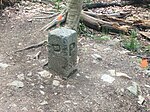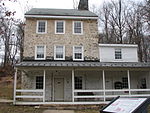Strickersville, Pennsylvania
AC with 0 elementsChester County, Pennsylvania geography stubsUnincorporated communities in Chester County, PennsylvaniaUnincorporated communities in Pennsylvania
Strickersville is an unincorporated community in extreme southeastern Chester County, Pennsylvania, United States. It is located at the intersection of Pennsylvania Route 896 and Strickersville Road in London Britain Township. While it once supported a number of small businesses in the late 19th century, today its location is marked only by the aforementioned crossroads and several historic homes. Lunn's Tavern, a large stone and brick building just north of the Strickersville Road intersection, is a listed in the National Register of Historic Places.
Excerpt from the Wikipedia article Strickersville, Pennsylvania (License: CC BY-SA 3.0, Authors).Strickersville, Pennsylvania
Strickersville Road, London Britain Township
Geographical coordinates (GPS) Address Nearby Places Show on map
Geographical coordinates (GPS)
| Latitude | Longitude |
|---|---|
| N 39.733888888889 ° | E -75.793055555556 ° |
Address
Strickersville Road 100
19350 London Britain Township
Pennsylvania, United States
Open on Google Maps









